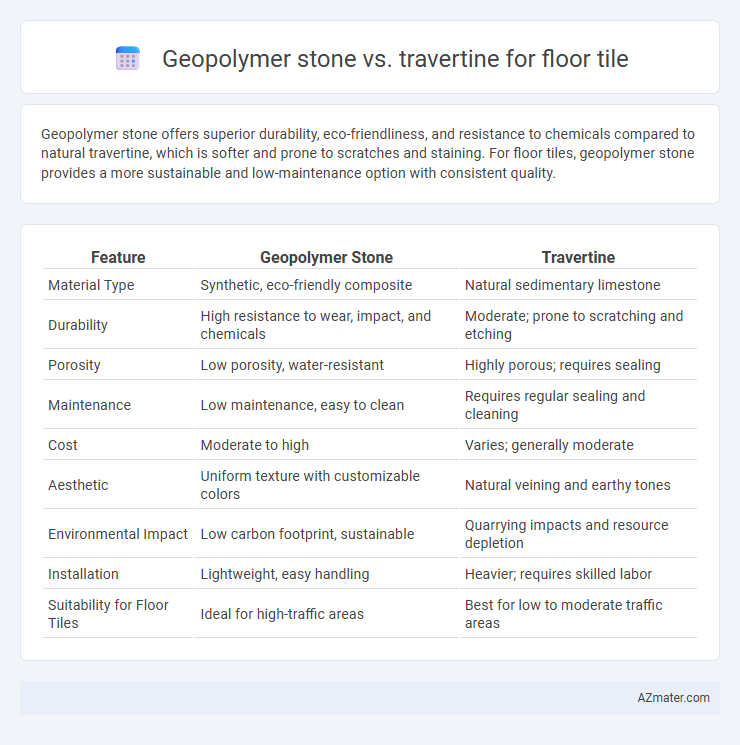Geopolymer stone offers superior durability, eco-friendliness, and resistance to chemicals compared to natural travertine, which is softer and prone to scratches and staining. For floor tiles, geopolymer stone provides a more sustainable and low-maintenance option with consistent quality.
Table of Comparison
| Feature | Geopolymer Stone | Travertine |
|---|---|---|
| Material Type | Synthetic, eco-friendly composite | Natural sedimentary limestone |
| Durability | High resistance to wear, impact, and chemicals | Moderate; prone to scratching and etching |
| Porosity | Low porosity, water-resistant | Highly porous; requires sealing |
| Maintenance | Low maintenance, easy to clean | Requires regular sealing and cleaning |
| Cost | Moderate to high | Varies; generally moderate |
| Aesthetic | Uniform texture with customizable colors | Natural veining and earthy tones |
| Environmental Impact | Low carbon footprint, sustainable | Quarrying impacts and resource depletion |
| Installation | Lightweight, easy handling | Heavier; requires skilled labor |
| Suitability for Floor Tiles | Ideal for high-traffic areas | Best for low to moderate traffic areas |
Introduction: Geopolymer Stone and Travertine Overview
Geopolymer stone is an innovative, eco-friendly material composed of industrial byproducts like fly ash and slag, offering high durability and chemical resistance for floor tiles. Travertine, a natural sedimentary limestone formed from mineral springs, presents unique porous textures and warm earthy tones ideal for classic flooring aesthetics. Comparing the two, geopolymer stone provides enhanced sustainability and strength, while travertine delivers natural beauty and traditional appeal.
Composition and Formation
Geopolymer stone is composed of industrial byproducts like fly ash and slag, which undergo a chemical activation process to form a durable, synthetic material through geopolymerization. Travertine is a natural sedimentary rock formed from the precipitation of calcium carbonate in mineral springs, creating a porous, textured surface with natural veining. The synthetic origin of geopolymer stone allows for greater uniformity and lower environmental impact, while travertine offers unique patterns and a classic aesthetic formed over thousands of years.
Aesthetic Appeal and Design Versatility
Geopolymer stone offers a modern, customizable aesthetic with a wide range of color options and textures, making it ideal for contemporary and unique floor tile designs. Travertine provides a classic, natural beauty characterized by earthy tones and distinctive veining, lending warmth and timeless elegance to interior spaces. Both materials deliver distinct design versatility, with geopolymer stone excelling in precision finishes and travertine embodying organic variations for a sophisticated look.
Durability and Longevity Comparison
Geopolymer stone flooring offers superior durability due to its synthetic composition, which resists cracking, wear, and chemical damage better than natural Travertine. Travertine, while aesthetically appealing with its natural veining, is more porous and prone to staining, erosion, and chipping over time, reducing its longevity in high-traffic areas. The engineered properties of geopolymer stone make it a more resilient and long-lasting choice for floor tiles, especially in environments requiring high durability and minimal maintenance.
Sustainability and Environmental Impact
Geopolymer stone flooring offers a highly sustainable alternative to travertine due to its use of industrial byproducts like fly ash and slag, reducing landfill waste and lowering carbon emissions associated with traditional stone quarrying. Travertine extraction involves significant environmental disruption through quarrying processes, contributing to habitat loss and higher energy consumption. The lower embodied energy and recyclability of geopolymer stone make it an eco-friendly choice for flooring applications focused on minimizing environmental impact.
Cost Analysis: Initial Investment and Maintenance
Geopolymer stone offers a lower initial investment compared to natural travertine due to its synthetic manufacturing process, which reduces extraction and transportation costs. Maintenance expenses for geopolymer stone are typically minimal, requiring only occasional cleaning without the need for sealing or repairs common to travertine. Travertine's porous nature results in higher maintenance costs over time, including regular sealing and potential staining treatments, increasing the overall lifecycle expense.
Installation Process and Challenges
Geopolymer stone offers a more straightforward installation process compared to travertine, as it is pre-cast and uniform in size, reducing the need for extensive cutting and leveling. Travertine requires careful handling due to its natural porosity and varying thickness, often necessitating additional sealing and surface preparation to prevent damage and staining during installation. The primary challenge with travertine lies in its natural variability, which demands skilled labor to ensure a level floor and cohesive pattern, whereas geopolymer stone's consistent composition simplifies alignment and grout application.
Performance: Stain, Scratch, and Moisture Resistance
Geopolymer stone offers superior stain resistance compared to travertine due to its non-porous surface, which inhibits absorption of liquids and prevents discoloration. In terms of scratch resistance, geopolymer stone demonstrates higher durability, maintaining a smooth and unblemished floor surface under heavy foot traffic or furniture movement. Moisture resistance is significantly better in geopolymer stone, making it ideal for areas prone to humidity or spills, whereas travertine's natural porosity requires sealing to mitigate water damage and potential staining.
Applications in Residential and Commercial Flooring
Geopolymer stone offers high durability, chemical resistance, and eco-friendly properties, making it ideal for high-traffic residential and commercial flooring applications where sustainability and low maintenance are priorities. Travertine flooring provides classic aesthetic appeal with its natural texture and warm tones, favored in residential settings like living rooms and kitchens, as well as commercial spaces such as hotel lobbies and retail stores that emphasize luxury and style. While geopolymer stone excels in areas prone to wear and moisture, travertine requires regular sealing to maintain its appearance and longevity under heavy commercial use.
Key Takeaways: Choosing the Right Material
Geopolymer stone offers superior durability, chemical resistance, and eco-friendly benefits compared to travertine, making it ideal for high-traffic or outdoor floor tile applications. Travertine provides natural elegance and unique veining but requires more maintenance due to its porosity and susceptibility to staining. Selecting the right material depends on balancing aesthetic preferences with practical needs such as longevity, maintenance, and environmental impact.

Infographic: Geopolymer stone vs Travertine for Floor tile
 azmater.com
azmater.com